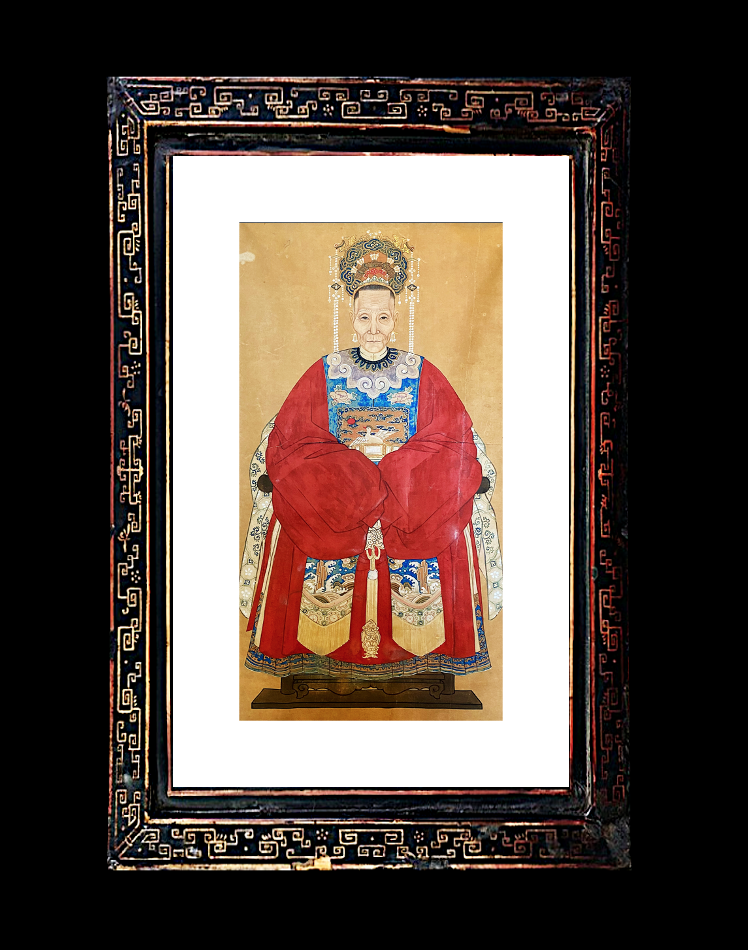

Title: Original Chinese Antique Ancestor Portrait Watercolor Painting
Shipping: $29.00
Artist: N/A
Period: 19th Century
History: Art
Origin: Central Asia > China
Condition: N/A
Item Date: N/A
Item ID: 467
A Beautiful Original and Rare 19th-Century Chinese Antique Ancestor Portrait Watercolor Painting. The 19th century was a significant period in Chinese history, marked by political, cultural, and artistic changes. During this time, ancestor portrait watercolor paintings emerged as a popular form of art in China, reflecting the societal and cultural trends of the era. Ancestor portrait watercolor paintings, also known as "minghua" in Chinese, were typically commissioned by affluent families to commemorate their ancestors and display their lineage. These paintings were highly valued and served as a way to honor and remember deceased family members, as well as to demonstrate the family's social status and wealth. The ancestor portrait watercolor paintings of the 19th century were typically created on silk or paper using watercolor pigments. The subjects of the paintings were usually depicted in a realistic style, with intricate details and vibrant colors. The paintings often depicted the ancestors in formal attire, seated or standing, and surrounded by auspicious symbols such as flowers, birds, and clouds. The backgrounds were typically simple and unadorned, with a focus on the central figure or figures. One significant development during the 19th century was the integration of Western artistic techniques and influences into Chinese painting. The introduction of Western watercolor techniques, materials, and subject matters, as well as the influence of Western missionaries and traders, had an impact on Chinese art during this time. This resulted in a fusion of traditional Chinese painting styles with Western elements, including the use of perspective, shading, and more naturalistic representations of human figures in ancestor portrait watercolor paintings. Another important aspect of 19th-century Chinese ancestor portrait watercolor paintings was the emphasis on family and lineage. These paintings were not only considered as works of art, but also as symbols of family honor and continuity. They were often displayed in prominent places within the family home, such as ancestral halls or ancestral altars, and were used during ancestral worship ceremonies. Furthermore, the 19th century was a period of social and political changes in China, including the decline of the Qing Dynasty and the impact of Western imperialism. As a result, ancestor portrait watercolor paintings also reflected changing social and cultural values. For example, some paintings during this time began to depict women and children, whereas earlier ancestor portraits typically focused solely on male ancestors. This shift in subject matter reflected changing gender roles and family dynamics in 19th-century Chinese society. In conclusion, the 19th century was a significant period for Chinese ancestor portrait watercolor paintings, marked by a fusion of traditional Chinese painting styles with Western influences, an emphasis on family and lineage, and reflections of changing social and cultural values. These paintings continue to be valued as important cultural artifacts and works of art, providing insights into China's history, culture, and artistic traditions.
Chinese watercolor painting, also known as traditional Chinese painting or guóhuà (国画), has a long and rich history that dates back thousands of years. The exact year of its origin is difficult to pinpoint, as it evolved over time and was influenced by various cultural, historical, and artistic factors. However, it is believed that Chinese watercolor painting has its roots in ancient China, with evidence of early Chinese watercolor paintings dating as far back as the Tang Dynasty (618-907 AD) and the Song Dynasty (960-1279 AD). Chinese watercolor painting has been highly regarded and treasured in Chinese culture for centuries. It has been considered not only as a form of artistic expression, but also as a means of cultivating moral character and spiritual enlightenment. In traditional Chinese culture, commissioning a watercolor painting was often seen as a way to express one's appreciation for the beauty of nature, convey personal emotions or aspirations, or commemorate significant life events. It was also believed to bring good fortune and blessings to the family. Commissioning a Chinese watercolor painting was considered an important cultural and social practice among Chinese families, especially those of higher social status or wealth. It was often associated with Confucian values of filial piety, where family members would honor and respect their ancestors by commissioning paintings that depicted scenes from nature, historical figures, or family portraits. These commissioned paintings were often displayed prominently in the family home and passed down through generations as cherished family heirlooms, symbolizing the family's cultural heritage and values. In addition to its cultural significance, Chinese watercolor painting was also highly regarded for its artistic excellence and technical skill. Chinese watercolor artists were highly trained and skilled in the use of brush and ink techniques, and their works were admired for their elegance, simplicity, and expressive power. The process of commissioning a Chinese watercolor painting involved close collaboration between the artist and the patron, with the patron providing guidance and input on the subject matter, composition, and style of the painting. Overall, Chinese watercolor painting has a long history and has been highly valued both culturally and artistically in Chinese society. Commissioning these paintings was an important practice for many Chinese families, as it was considered a way to express cultural identity, commemorate important events, and honor ancestors, while also appreciating the artistic skill and beauty of the paintings themselves.